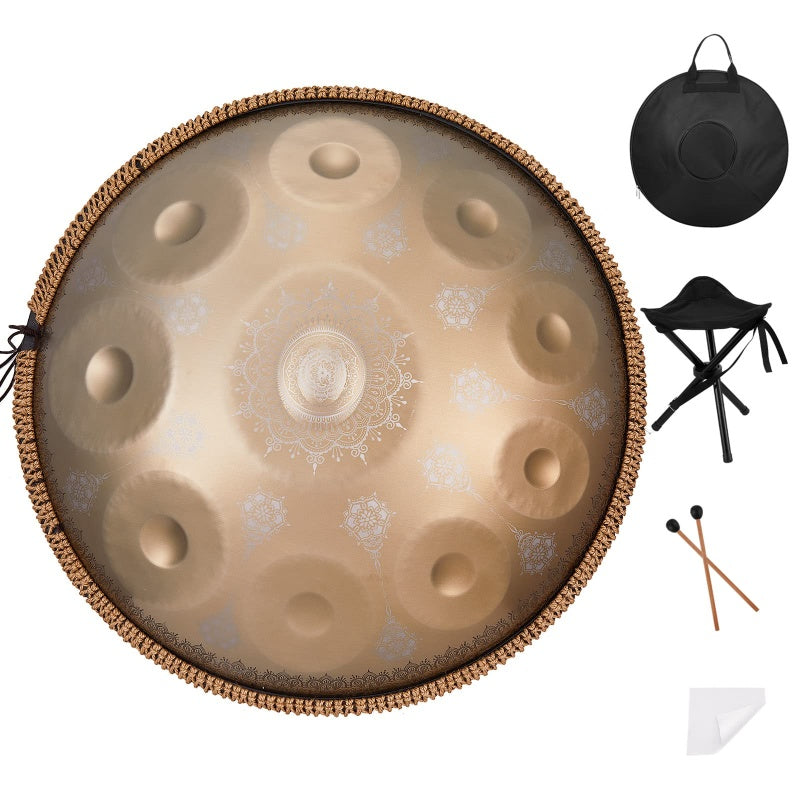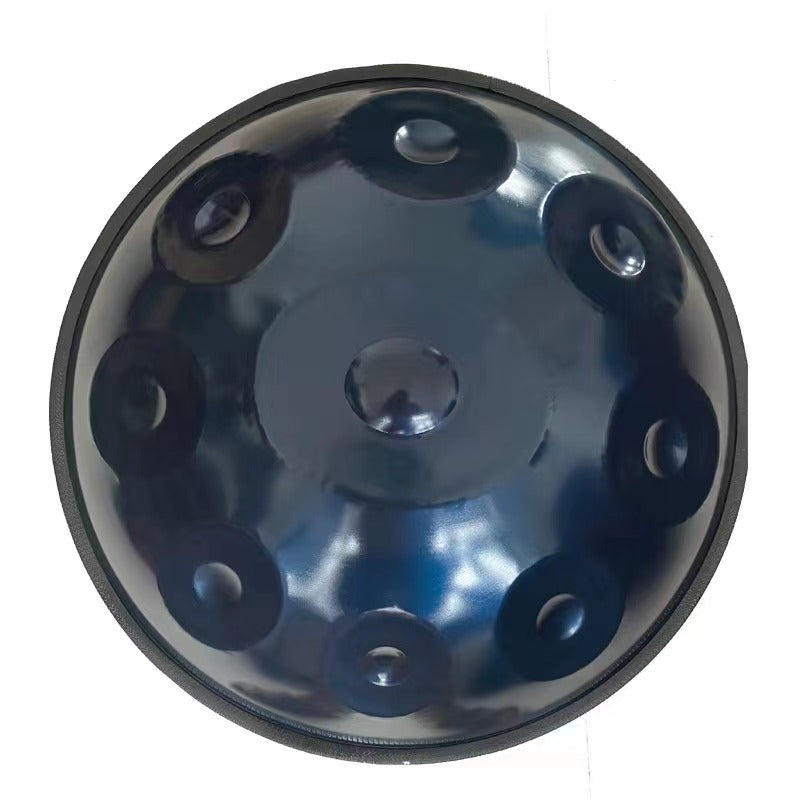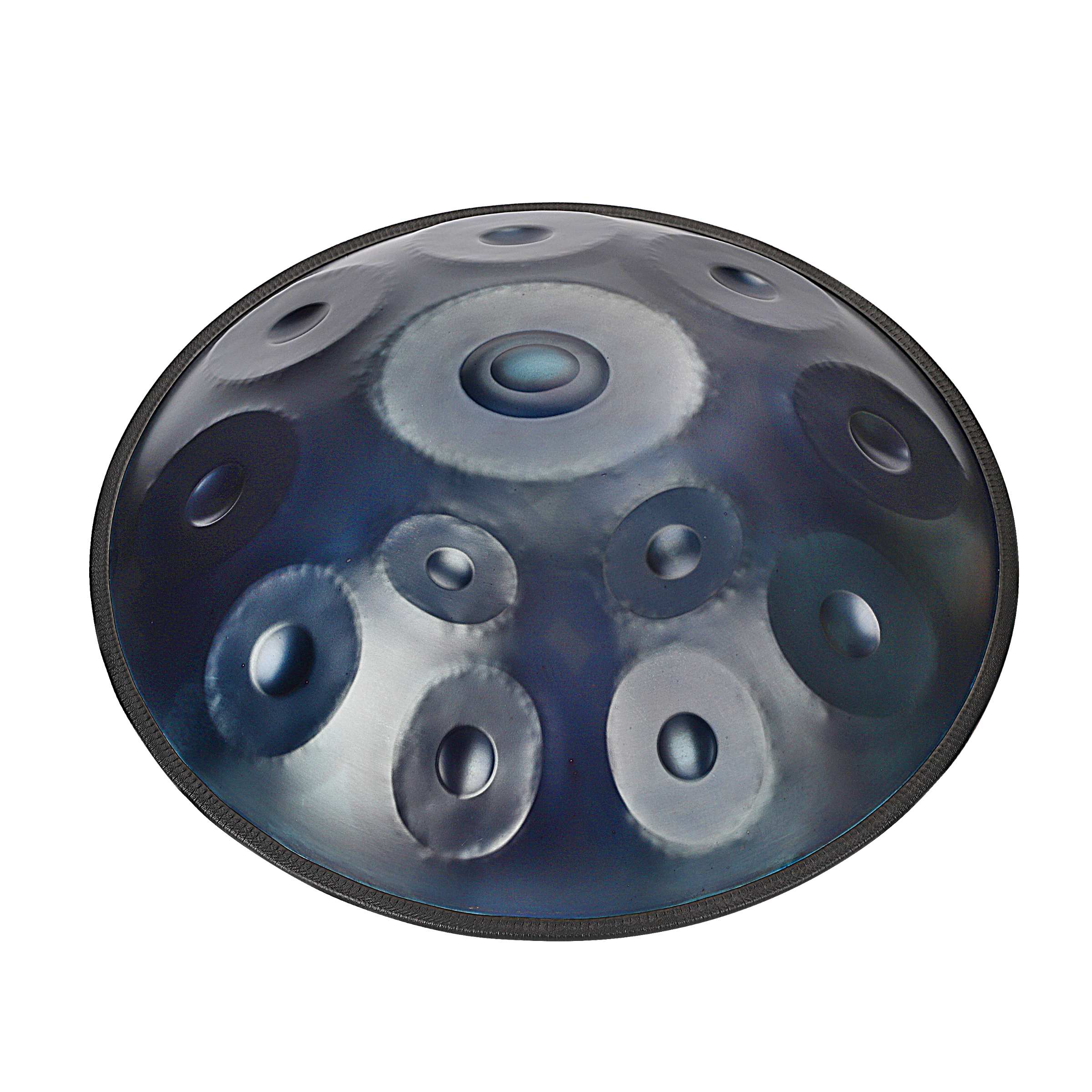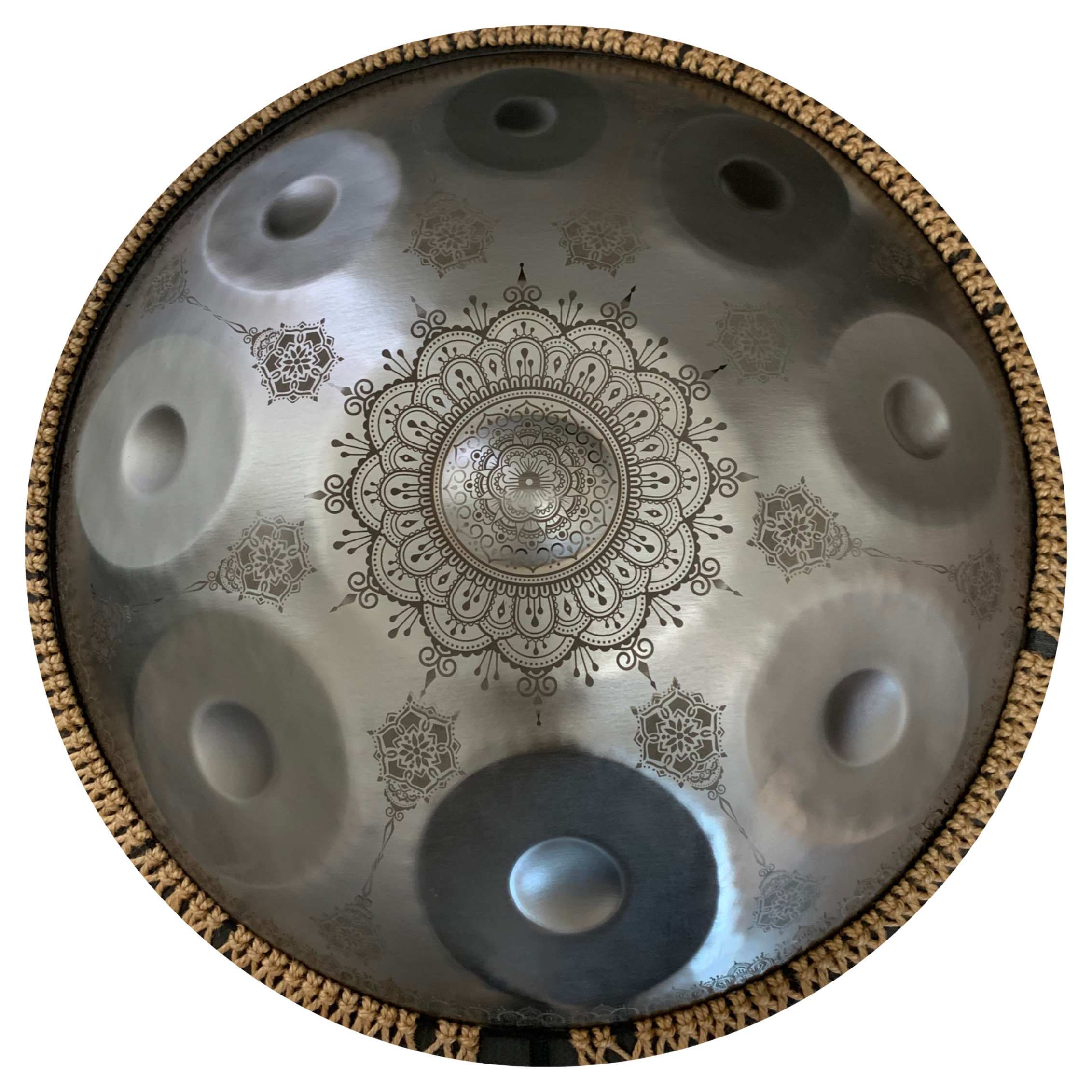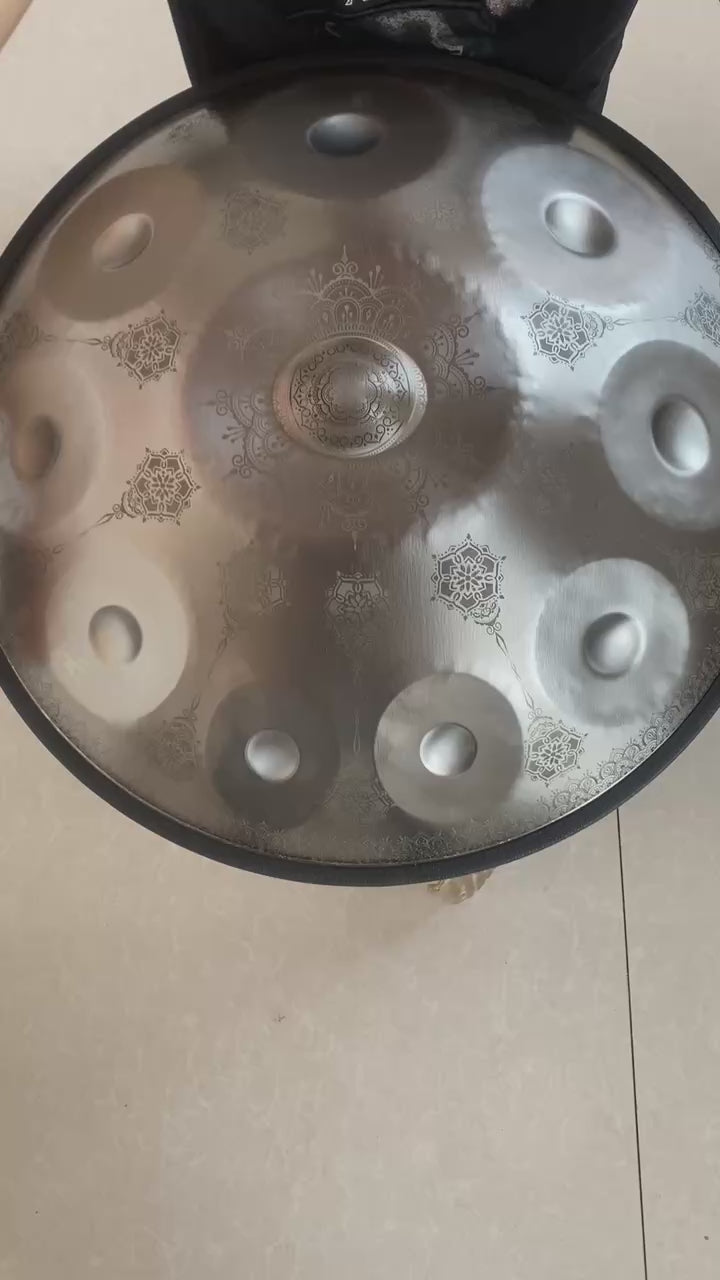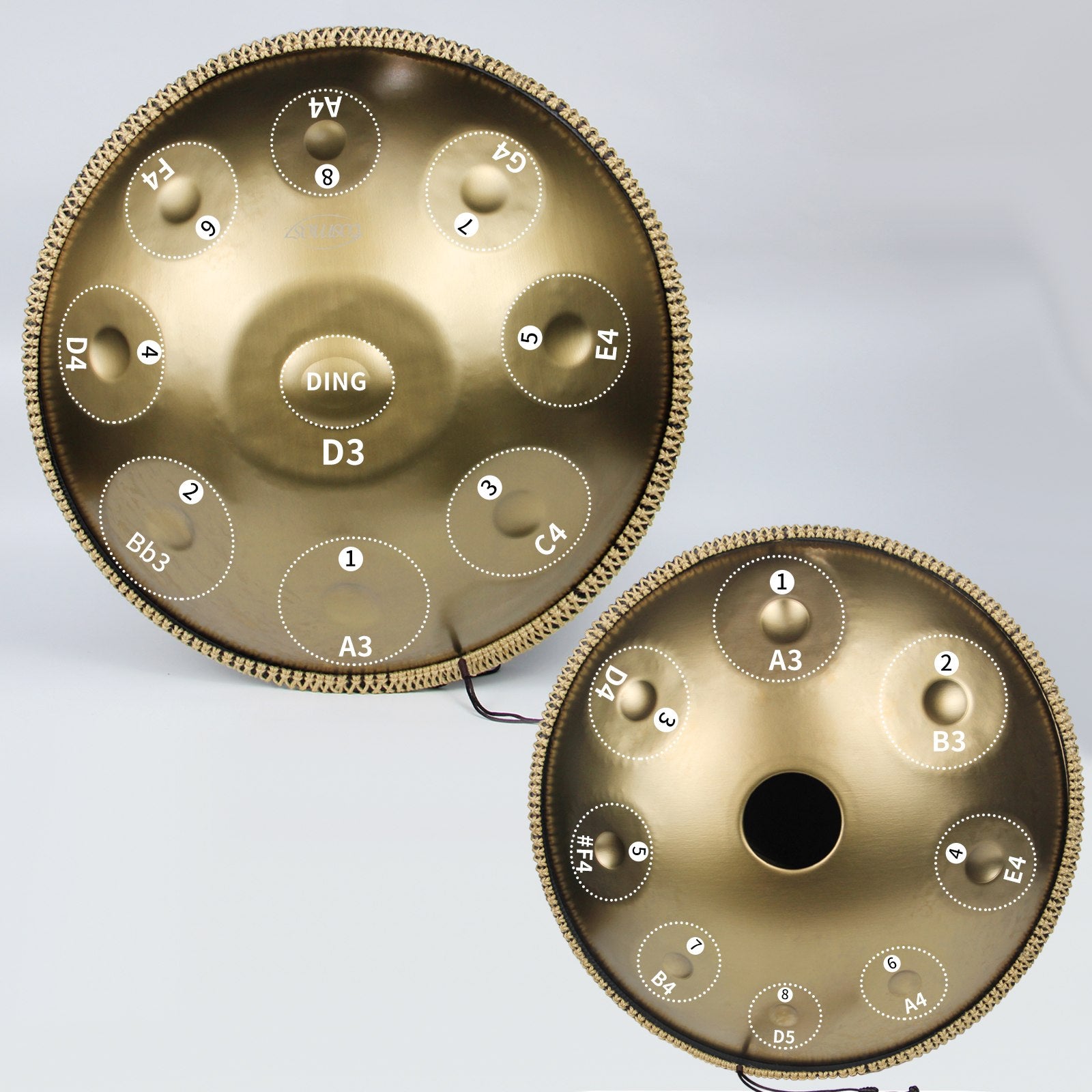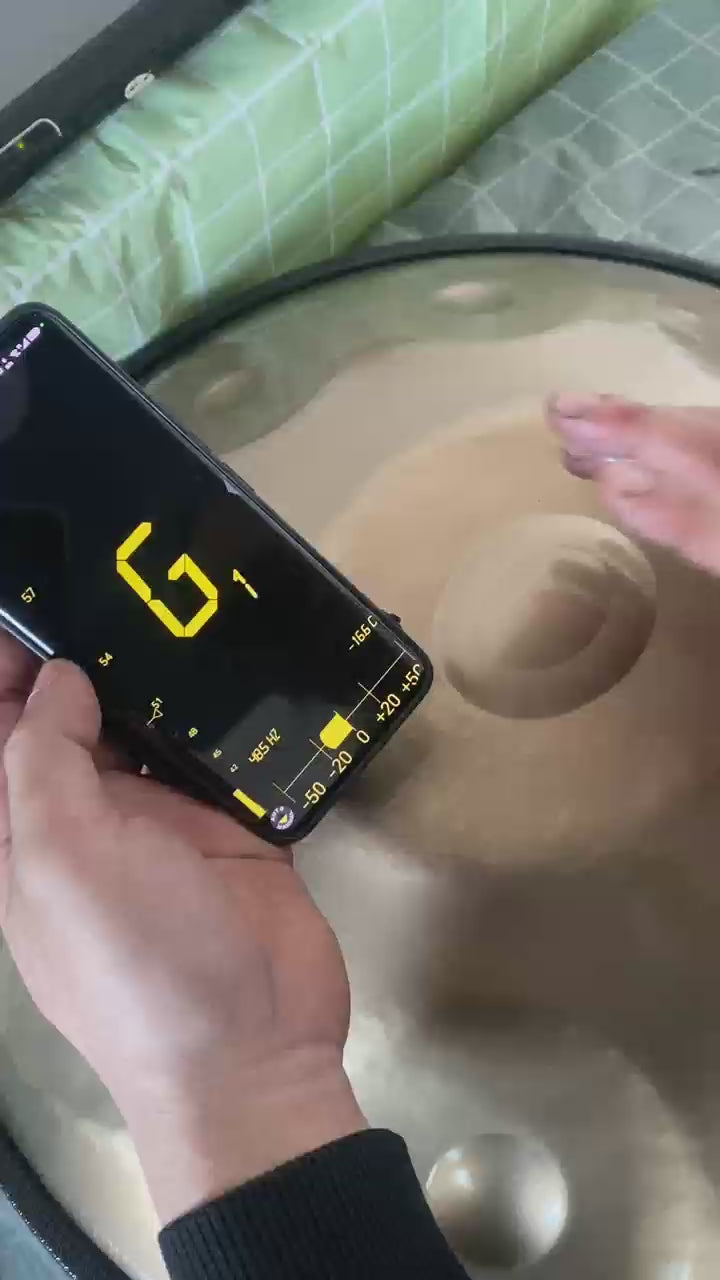Beide Namen, „Hangdrum“ und „Handpan“, können austauschbar verwendet werden, aber es gibt einige Unterschiede zwischen den beiden. Dieser Vergleich wird ihre Entstehung, Architektur, Akustik sowie Zugänglichkeit betrachten, um diese einzigartigen Instrumente zu erklären und Ihnen bei der Entscheidung zu helfen, welches von ihnen perfekt für Sie ist.

Ursprünge und Terminologie
Die Hang, die 2000 von Felix Rohner & Sabina Schärer von PANArt in der Schweiz geschaffen wurde, ist die erste ihrer Art. Das Wort „Hang“ übersetzt sich im Bernerdeutsch zurück zu „Hand“; das Instrument wird mit der Hand gespielt. Die Hang hat eine konvexe Form mit einer zentralen Kuppel, die als „Ding“ bekannt ist, und darum herum befinden sich gestimmte Klangfelder.
Andererseits wurde der Begriff „Handpan“ ab 2007 von Kyle Cox von Pantheon Steel verwendet, um Hang-ähnliche Instrumente zu bezeichnen, die von anderen Unternehmen hergestellt werden. Handpans können als Teil einer umfangreicheren Klasse ähnlicher Instrumente in Bezug auf Konstruktion und Handhabung angesehen werden (Descriptive Audio) (Sound Artist).
Bau und Materialien
Hang Drum: Originale Hang Drums bestehen aus einer Stahllegierung, die hauptsächlich für die Verwendung im Hang und von PANArt entwickelt wurde. Darin befinden sich diese Instrumente, die aus zwei tiefgezogenen und miteinander verschweißten Stahlgehäusen gebaut wurden, was ihnen ihr unverwechselbares Aussehen einer fliegenden Untertasse verleiht. Die genaue Kombination der Stähle wird nicht offengelegt, was ein ansprechender Faktor für die Legende des Hangs ist.
Handpan: Die meisten Handpans werden aus Edelstahl oder nitriertem Stahl hergestellt; diese Materialien sind robust und korrodieren kaum. Die Konstruktion kann entweder aus einem tiefgezogenen Einzelgehäuse oder aus zwei Gehäusen bestehen. Das für die Handpan-Konstruktion verwendete Material kann variieren, was es den Herstellern ermöglicht, die Legierung in Bezug auf ihre Behandlung zu ändern, um die Klangqualität des Instruments zu verbessern.
Klang und Spielbarkeit
Hang Drum: Die Hang erzeugt kraftvolle, warme und tiefe Klänge, die sich gut für Entspannung und Meditation eignen. Dieser besondere Klang ist auf die speziellen Stimmverfahren von PANArt zurückzuführen, bei denen jeder Ton auf einen Grundton, eine Oktave und eine übermäßige Quinte gestimmt ist.
Handpan: Handpans sind im Vergleich zum Hang vielseitiger in Bezug auf die Tonoptionen und Stimmungen, die jede einzelne Pfanne haben kann. Sie können von 7 bis 30 Noten reichen, und es hängt vom Hersteller und dem Modell des Instruments ab. Diese Art von Variation trägt zur polyphonen Variation bei, was wiederum die Chancen auf Freiheit und Innovation beim Musizieren erhöht. Handpans sind im Allgemeinen leichter zu erlernen, aufgrund des Layouts der Noten, und es ist möglich, sowohl perkussive als auch melodische Musik darauf zu spielen.
Verfügbarkeit und Preise
Hang Drum: PANArt stellte 2014 die Herstellung von Hang ein; daher sind sie einzigartig, und die Menschen suchen nach gebrauchten Hang-Instrumenten. Aufgrund der Knappheit sind sie teuer und können zwischen 5.000 und 15.000 Dollar kosten.
Handpan: Handpans können von verschiedenen Verkäufern aus einer Vielzahl von Ländern auf der ganzen Welt gekauft werden. Die Kosten für eine neue Handpan liegen zwischen 800 und 6.000 $, abhängig von der Gesamtqualität, der Anzahl der Töne und den Modifikationsmöglichkeiten. Aus diesem Grund sind Handpans für die meisten Musiker deutlich einfacher zu spielen als Trommeln.
Lernen und Wartung
Lernfreundlichkeit: Sie sind beide leicht zu lernen, obwohl Handpans aufgrund ihres Layouts etwas einfacher zu beginnen sind. Ausgewogene und angenehme Musik auf der Handpan zu komponieren, ist im Vergleich zu anderen Percussion-Instrumenten relativ einfacher.
Wartung: Flöten und Klarinetten erfordern beide eine ordnungsgemäße Handhabung und manchmal eine professionelle Stimmung; aus diesen Gründen benötigen sie ständige Wartung. Handpans müssen möglicherweise aufgrund von Temperatur- und Feuchtigkeitsproblemen häufiger nachjustiert werden. Bei professioneller Stimmung bleibt das Instrument mit einem tiefen und klingenden Ton lebendig.
Die richtige Wahl des Instruments
Berücksichtigen Sie Ihre Ziele: Wenn Sie ein Sammler oder ein Musiker sind, der ein sehr seltenes und ungewöhnliches Musikinstrument spielen möchte, dann könnte die Hang Drum für Sie von Wert sein, auch wenn sie immer noch sehr, sehr teuer ist. Sei es für ihre warmen Töne, die das Gefühl von Musikgeschichte tragen, oder einfach die Möglichkeit, Erbe dieser schönen Tradition zu werden, falls man bereit ist, sie zu kaufen – die Ukulele ist ein Instrument der Träume.
Praktikabilität und Vielseitigkeit: Für die Mehrheit der Performer ist ein Handpan vorteilhafter; es ist nützlicher. Im Allgemeinen sind Handpans vielseitiger, da mehr Skalen in ihrem Fall gewählt werden können, die Optionen sind ebenfalls individuell und die Kosten sind mehrere Male niedriger. Es wird für meditative-ambient Musik sowie dynamische Pop-, Rock-, Punk-, Hip-Hop- und andere rhythmische Musik empfohlen.
Hang Drum vs. Handpan Vergleichstabelle
|
Merkmale |
Hängetrommel |
Handpfanne |
|
Herkunft |
Erfunden von PANArt im Jahr 2000, Schweiz |
Inspiriert von der Hang Drum, verschiedene Hersteller weltweit seit 2007 |
|
Material |
Proprietäre Stahllegierung |
Edelstahl oder nitrierter Stahl |
|
Konstruktion |
Zwei tiefgezogene Stahlgehäuse, die miteinander verschmolzen sind. |
Einzelblatt oder zwei Schalen, tiefgezogen |
|
Klang |
Warme, resonante Töne mit harmonischer Stimmung |
Breite Palette von Tönen und Skalen, perkussiv und melodisch |
|
Gewicht |
13-18 Pfund (5,9-8,2 kg) |
8-12 Pfund (3,6-5,4 kg) |
|
Abmessungen |
21-24 Zoll (53-60 cm) Durchmesser |
Ungefähr 20 Zoll (50 cm) Durchmesser |
|
Verfügbarkeit |
Begrenzter, gebrauchter Markt nur |
Weit verbreitet von vielen Herstellern |
|
Preisklasse |
5.000 bis 15.000 US-Dollar |
800 bis 6.000 US-Dollar |
|
Einfaches Lernen |
Mäßig |
Im Allgemeinen einfacher für Anfänger |
|
Wartung |
Benötigt regelmäßige professionelle Abstimmung |
Benötigt regelmäßige professionelle Abstimmung |
Abschluss
Handpan ist dem Hang Drum sehr ähnlich und bietet eine unverwechselbare musikalische Essenz seines Spiels und Klangs. Die Hang Drum, mit ihrem antiken Ursprung und ihrer Seltenheit, bleibt für viele Menschen, hauptsächlich für Instrumental-Enthusiasten, von Interesse. Auf der anderen Seite bietet die Handpan eine breitere Palette musikalischer Optionen im Vergleich zur Experimentation und ist für Musiker nahezu jeden Niveaus zugänglich. Es ist wichtig, Ihre Aspirationen als Musiker und Ihre finanziellen Mittel zu verstehen, damit Sie die richtige Entscheidung zwischen den beiden beeindruckenden Instrumenten treffen können.

